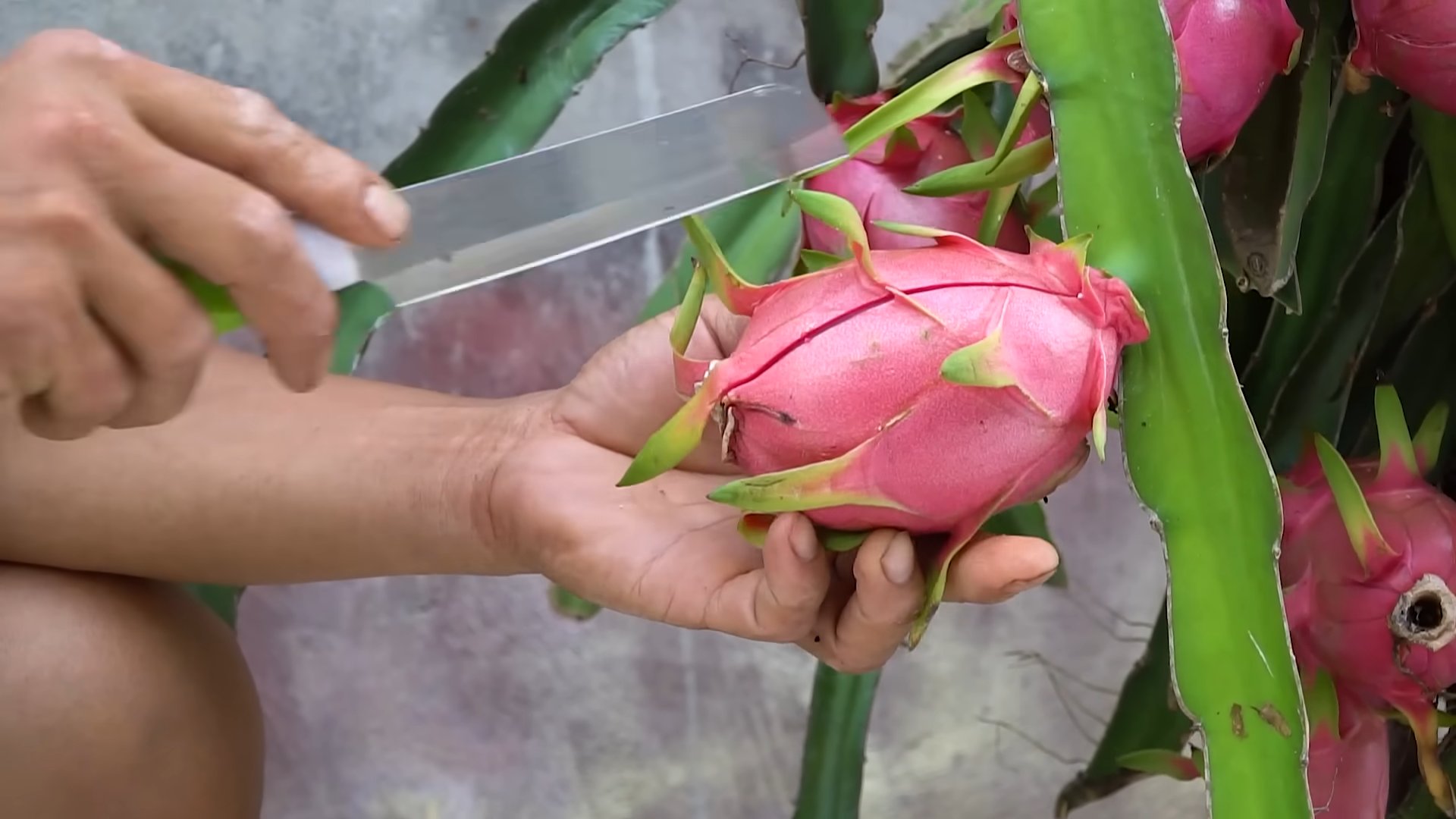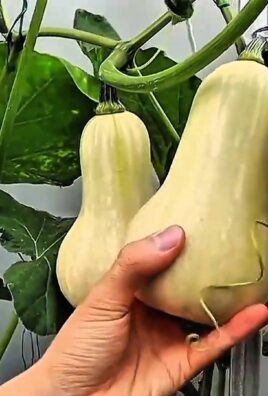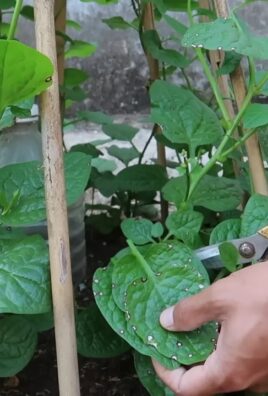Grow Dragon Fruit Home – sounds like a tropical dream, right? Well, it doesn’t have to be just a dream! I’m here to tell you that cultivating this exotic fruit in your own backyard (or even indoors!) is totally achievable with a few simple tricks and DIY techniques. Forget those expensive grocery store prices; imagine plucking your own vibrant, sweet dragon fruit straight from the vine!
Dragon fruit, also known as pitaya, has a fascinating history, originating in Central America and making its way to Southeast Asia, where it’s now widely cultivated. In some cultures, it’s even considered a symbol of good luck and prosperity! But beyond its cultural significance, the real magic lies in its delicious flavor and impressive nutritional benefits.
Why should you learn these DIY tricks for growing dragon fruit at home? Because let’s face it, who wouldn’t want a taste of the tropics without breaking the bank? Plus, growing your own food is incredibly rewarding! You’ll know exactly what’s going into your fruit (no nasty pesticides!), and you’ll get the satisfaction of nurturing something from a small cutting to a thriving, fruit-bearing plant. This article is packed with easy-to-follow tips and hacks that will empower you to grow dragon fruit home successfully, even if you don’t have a green thumb. So, grab your gardening gloves, and let’s get started!

Growing Dragon Fruit at Home: A Comprehensive DIY Guide
Hey there, fellow plant enthusiasts! Ever dreamt of harvesting your own exotic dragon fruit? Well, dream no more! Growing dragon fruit at home is totally achievable, even if you don’t have a sprawling tropical orchard. I’m going to walk you through everything you need to know, from choosing the right variety to enjoying your first homegrown fruit. Let’s get started!
Choosing Your Dragon Fruit Variety
Before we dive into the nitty-gritty, let’s talk about varieties. Not all dragon fruit are created equal, and some are better suited for home growing than others. Here’s a quick rundown:
* Hylocereus undatus (White-fleshed): This is the most common variety, known for its slightly sweet, refreshing flavor. It’s a reliable producer and relatively easy to grow.
* Hylocereus costaricensis (Red-fleshed): If you’re looking for a more intense flavor and vibrant color, this is your go-to. It’s a bit more finicky than the white-fleshed variety, but the reward is worth it.
* Hylocereus megalanthus (Yellow-skinned): This variety boasts a unique yellow skin and sweet, aromatic white flesh. It’s self-pollinating, which is a huge plus for home growers!
* Self-pollinating vs. Cross-pollinating: This is crucial! Some dragon fruit varieties need pollen from a different variety to produce fruit. Self-pollinating varieties, like the yellow-skinned one, can fruit on their own. If you’re only growing one plant, definitely choose a self-pollinating variety. If you want to grow a cross-pollinating variety, you’ll need at least two different varieties that can pollinate each other.
Getting Started: What You’ll Need
Okay, now that you’ve chosen your variety, let’s gather our supplies. Here’s what you’ll need to get your dragon fruit journey started:
* Dragon Fruit Cutting or Seedling: You can purchase these online or at your local nursery. Cuttings are generally faster to fruit than seedlings.
* Large Pot (at least 20 gallons): Dragon fruit plants need plenty of room for their roots to grow. A large pot is essential.
* Well-Draining Soil: Dragon fruit hate soggy roots! A mix of cactus potting mix, perlite, and compost works wonders.
* Sturdy Support Structure: These plants are climbers! You’ll need a trellis, post, or other structure for them to grow on. A strong stake with a circular support at the top is ideal.
* Gardening Gloves: Trust me, you’ll want these. Dragon fruit plants have spines!
* Watering Can or Hose: For, well, watering!
* Fertilizer: A balanced fertilizer formulated for cacti or succulents.
* Pruning Shears: For keeping your plant tidy and encouraging fruit production.
Planting Your Dragon Fruit
Alright, let’s get our hands dirty! Here’s how to plant your dragon fruit:
1. Prepare the Pot: Fill your large pot with your well-draining soil mix, leaving a few inches of space at the top.
2. Plant the Cutting or Seedling: If you’re using a cutting, plant it about 2-3 inches deep. If you’re using a seedling, gently remove it from its container and plant it at the same depth it was growing in previously.
3. Position the Support Structure: Place your trellis or post in the center of the pot, making sure it’s sturdy and well-anchored.
4. Water Thoroughly: Water the soil until it’s evenly moist, but not soggy.
5. Secure the Plant to the Support: Gently tie the dragon fruit plant to the support structure using soft twine or plant ties. This will help it start climbing.
Caring for Your Dragon Fruit
Now that your dragon fruit is planted, it’s time to learn how to care for it. Here’s what you need to know:
* Sunlight: Dragon fruit plants need at least 6-8 hours of sunlight per day. A sunny spot on your patio or balcony is ideal. If you’re growing indoors, you’ll need to supplement with grow lights.
* Watering: Water deeply when the soil is dry to the touch. Avoid overwatering, as this can lead to root rot. In general, water more frequently during the growing season (spring and summer) and less frequently during the dormant season (fall and winter).
* Fertilizing: Feed your dragon fruit plant with a balanced fertilizer every 2-3 months during the growing season. Follow the instructions on the fertilizer label.
* Pruning: Pruning is essential for encouraging fruit production. Remove any dead or damaged branches, and trim back any overly long or unruly stems. The goal is to create a well-ventilated plant with plenty of light reaching all parts of the plant.
* Support: As your dragon fruit plant grows, continue to secure it to the support structure. You can use plant ties or twine to guide the stems.
* Pollination (if necessary): If you’re growing a cross-pollinating variety, you’ll need to hand-pollinate the flowers. This involves transferring pollen from one flower to another using a small brush. The flowers typically open at night and only last for one night, so you’ll need to be vigilant!
Troubleshooting Common Problems
Even with the best care, you might encounter some problems along the way. Here are a few common issues and how to address them:
* Yellowing Leaves: This could be a sign of overwatering, underwatering, or nutrient deficiency. Check the soil moisture and adjust your watering accordingly. If the problem persists, try fertilizing with a balanced fertilizer.
* Root Rot: This is caused by overwatering and poor drainage. If you suspect root rot, repot your plant in fresh, well-draining soil. Remove any affected roots.
* Pests: Dragon fruit plants can be susceptible to pests like aphids and mealybugs. Inspect your plant regularly and treat any infestations with insecticidal soap or neem oil.
* Lack of Fruit: This could be due to a variety of factors, including insufficient sunlight, lack of pollination, or nutrient deficiency. Make sure your plant is getting enough sunlight, hand-pollinate if necessary, and fertilize regularly.
Harvesting Your Dragon Fruit
The moment you’ve been waiting for! Harvesting your own dragon fruit is incredibly rewarding. Here’s how to know when your fruit is ripe:
* Color Change: The skin of the fruit will change color from green to bright pink, red, or yellow, depending on the variety.
* Slight Softness: The fruit should feel slightly soft to the touch, but not mushy.
* Easy Detachment: The fruit should detach easily from the stem with a gentle twist.
Once your dragon fruit is ripe, simply twist it off the stem and enjoy! You can eat it fresh, add it to smoothies, or use it in desserts.
Propagating Dragon Fruit
Want to expand your dragon fruit empire? Propagating dragon fruit is easy! Here’s how:
1. Take a Cutting: Choose a healthy stem that’s at least 12 inches long.
2. Let it Callus: Allow the cut end of the stem to callus over for a few days. This will help prevent rot.
3. Plant the Cutting: Plant the calloused end of the cutting in well-draining soil.
4. Water Sparingly: Water the cutting sparingly until it starts to root.
5. Wait Patiently: It can take several weeks for the cutting to root. Once it’s rooted, you can care for it as you would a mature dragon fruit plant.
Overwintering Dragon Fruit
If you live in an area with cold winters, you’ll need to protect your dragon fruit plant from frost. Here are a few options:
* Bring it Indoors: If your plant is in a pot, you can bring it indoors for the winter. Place it in a sunny location and water sparingly.
* Wrap it Up: If your plant is too large to move, you can wrap it in burlap or frost cloth to protect it from the cold.
* Provide Supplemental Heat: You can also use a heat lamp or heating mat to provide supplemental heat to your plant during cold snaps.
Building a Dragon Fruit Support Structure
As I mentioned earlier, a strong support structure is crucial for growing dragon fruit. While you can buy pre-made trellises, building your own is a fun and cost-effective option. Here’s a simple DIY support structure you can build:
1. Gather Your Materials: You’ll need a sturdy wooden post (at least 6 feet tall),

Conclusion
So, there you have it! Growing dragon fruit at home is not only achievable, but it’s also a deeply rewarding experience. Forget those expensive, often bland, store-bought fruits. Imagine plucking a vibrant, perfectly ripe dragon fruit straight from your own backyard – the taste difference is simply astounding. This DIY approach allows you to control every aspect of the growing process, ensuring you get the most flavorful and nutritious fruit possible.
This isn’t just about saving money; it’s about connecting with nature, learning a new skill, and enjoying the unparalleled satisfaction of nurturing something from a small cutting to a fruit-bearing plant. The vibrant colors of the fruit, the exotic beauty of the plant itself, and the sheer novelty of growing something so unique will undoubtedly impress your friends and family.
But the benefits don’t stop there. By growing your own dragon fruit, you’re contributing to a more sustainable lifestyle. You’re reducing your carbon footprint by eliminating the need for long-distance transportation and supporting local, homegrown produce. Plus, you’ll have a constant supply of fresh, organic fruit, free from harmful pesticides and chemicals.
Consider experimenting with different varieties of dragon fruit. The red-fleshed varieties are known for their intense sweetness, while the white-fleshed varieties offer a more subtle, refreshing flavor. You can even try growing yellow dragon fruit, which is prized for its exceptionally sweet and aromatic taste.
Don’t be afraid to get creative with your support structure. While a sturdy trellis is the most common option, you can also use repurposed materials like old tires or metal drums to create a unique and eye-catching display. Just make sure the structure is strong enough to support the weight of the mature plant and its fruit.
And remember, patience is key. Dragon fruit plants can take a few years to start producing fruit, but the wait is well worth it. In the meantime, enjoy the process of nurturing your plant and watching it grow.
We strongly encourage you to give this DIY trick a try. It’s easier than you might think, and the rewards are immense. Once you’ve harvested your first dragon fruit, you’ll be hooked! Share your experiences with us in the comments below. We’d love to hear about your successes, your challenges, and any tips you’ve learned along the way. Let’s build a community of dragon fruit enthusiasts and spread the joy of growing this amazing fruit at home! Embrace the journey of learning how to grow dragon fruit home and enjoy the fruits of your labor.
Frequently Asked Questions (FAQ)
What is the best climate for growing dragon fruit?
Dragon fruit thrives in warm, tropical, and subtropical climates. They need plenty of sunlight (at least 6-8 hours per day) and temperatures that stay above freezing. Ideally, temperatures should range between 65°F and 80°F (18°C and 27°C). If you live in a colder climate, you can still grow dragon fruit in containers and bring them indoors during the winter months. Make sure to provide them with adequate light and warmth indoors.
How often should I water my dragon fruit plant?
Watering frequency depends on the climate and soil conditions. Generally, dragon fruit plants need regular watering during the growing season (spring and summer). Water deeply when the top inch of soil feels dry. Avoid overwatering, as this can lead to root rot. In the winter, reduce watering significantly, allowing the soil to dry out more between waterings. Good drainage is essential for healthy growth.
What kind of soil is best for dragon fruit?
Dragon fruit plants prefer well-draining soil that is rich in organic matter. A mix of cactus potting mix, perlite, and compost is a good option. You can also add some sand to improve drainage. Avoid heavy clay soils, as they can retain too much moisture and lead to root rot. The ideal pH level for dragon fruit is between 6.0 and 7.0.
How do I fertilize my dragon fruit plant?
Fertilize your dragon fruit plant regularly during the growing season (spring and summer). Use a balanced fertilizer with a ratio of 10-10-10 or a fertilizer specifically formulated for cacti and succulents. Apply the fertilizer according to the package instructions. Avoid over-fertilizing, as this can burn the roots. You can also supplement with organic fertilizers like compost tea or worm castings.
How long does it take for a dragon fruit plant to produce fruit?
Dragon fruit plants typically take 1-3 years to start producing fruit, depending on the variety, growing conditions, and care. Grafted plants may fruit sooner than plants grown from cuttings. To encourage fruiting, make sure your plant receives plenty of sunlight, water, and fertilizer. You may also need to hand-pollinate the flowers, especially if you don’t have many pollinators in your area.
How do I hand-pollinate dragon fruit flowers?
Dragon fruit flowers are nocturnal, meaning they bloom at night. They are typically pollinated by bats and moths. If you don’t have these pollinators in your area, you may need to hand-pollinate the flowers. Use a small paintbrush to transfer pollen from the stamen (male part) of one flower to the stigma (female part) of another flower. It’s best to do this at night or early in the morning when the flowers are fully open.
What are some common pests and diseases that affect dragon fruit plants?
Dragon fruit plants are relatively pest and disease-resistant, but they can be susceptible to certain problems. Common pests include aphids, mealybugs, and scale insects. These can be controlled with insecticidal soap or neem oil. Root rot is a common disease that can occur if the soil is too wet. To prevent root rot, make sure your plant has good drainage and avoid overwatering. Other potential diseases include fungal infections, which can be treated with fungicides.
How do I prune my dragon fruit plant?
Pruning is important for maintaining the shape and health of your dragon fruit plant. Remove any dead, damaged, or diseased branches. You can also prune to control the size and shape of the plant. Prune after the fruiting season to encourage new growth. Be careful not to over-prune, as this can reduce fruit production.
Can I grow dragon fruit in a container?
Yes, dragon fruit can be successfully grown in containers, making it a great option for those with limited space or colder climates. Choose a large container with good drainage. Use a well-draining potting mix and provide a sturdy support structure for the plant to climb on. Water and fertilize regularly, and bring the container indoors during the winter months if you live in a colder climate.
What are the different varieties of dragon fruit?
There are many different varieties of dragon fruit, each with its own unique characteristics. Some popular varieties include:
* **Hylocereus undatus (White-fleshed):** This is the most common variety, with white flesh and black seeds. It has a mild, refreshing flavor.
* **Hylocereus costaricensis (Red-fleshed):** This variety has red flesh and black seeds. It is sweeter and more flavorful than the white-fleshed variety.
* **Hylocereus megalanthus (Yellow-fleshed):** This variety has yellow skin and white flesh with black seeds. It is known for its exceptionally sweet and aromatic taste.
* **Hylocereus guatemalensis (Purple-fleshed):** This variety has purple flesh and black seeds. It has a slightly tart flavor.
Experiment with different varieties to find your favorite!




Leave a Comment